#katazome
Explore tagged Tumblr posts
Text

my laser cut stencils are here yayyyyyy
21 notes
·
View notes
Text
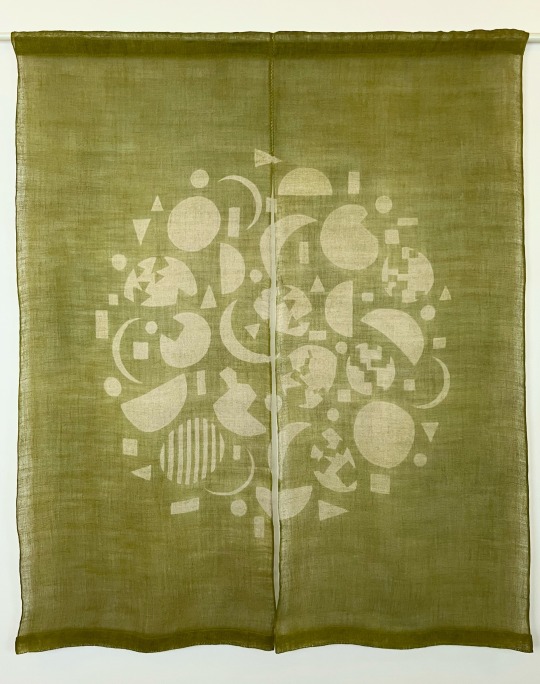
2022年制作
「満ち欠け暖簾-芥子色-」
#katazome#dyeing#textiledesign#textile#art#artwork#noren#型染#かたぞめ#アート#アートワーク#染色#テキスタイル#テキスタイルデザイン#のれん#暖簾
7 notes
·
View notes
Photo

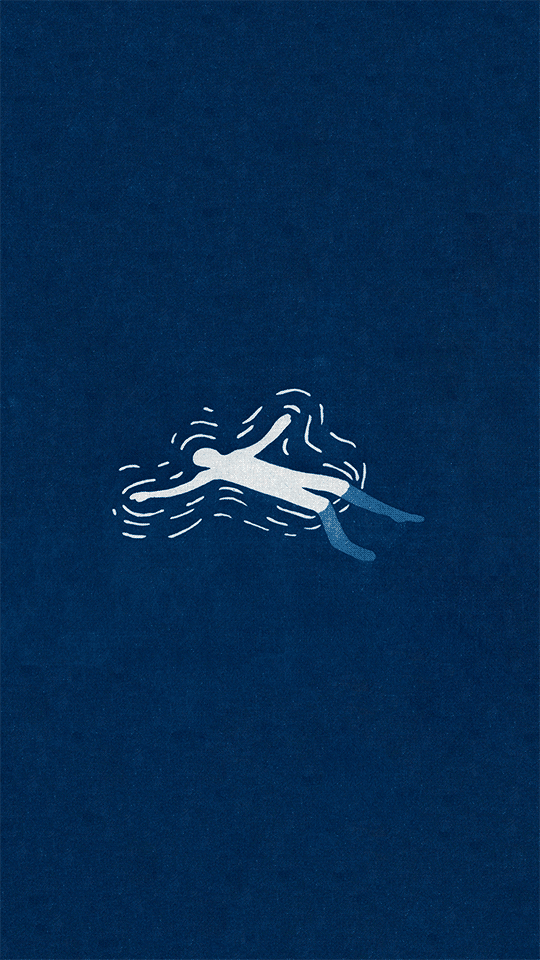

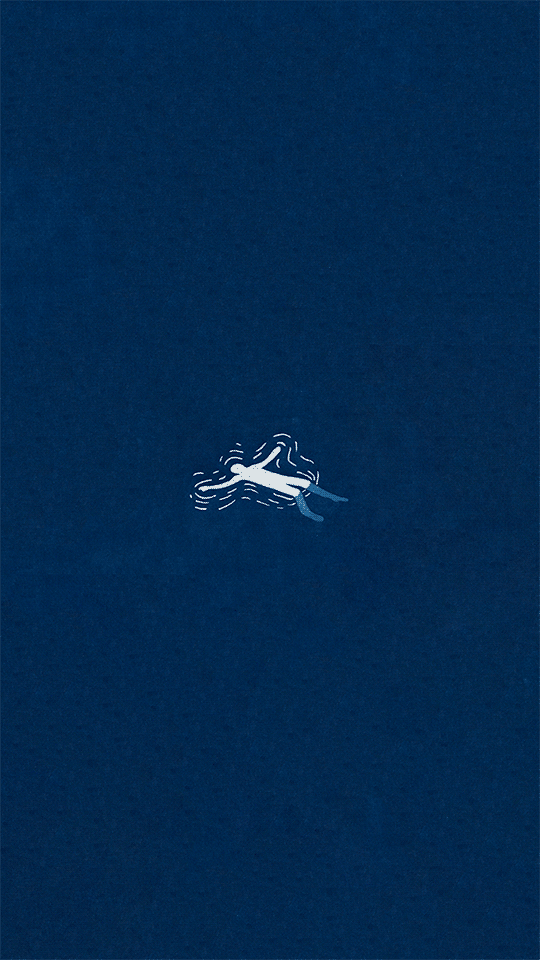
I drew an animation based on a piece by @malatalia_
Stills dyed in indigo using the katazome method by @malatalia_
18K notes
·
View notes
Text
Word List: Fashion History
to try to include in your poem/story (pt. 2/3)
Exomis - a short, asymmetrical wrap garment pinned at the left shoulder, worn by men in Ancient Greece
Eye of Horus - or Wedjat eye, is an ancient Egyptian symbol that represents the eye of the falcon-headed god Horus and symbolizes healing and regeneration and was often worn for protection
Faience - a man-made ceramic material that was often used in ancient Egypt to make jewelry and devotional objects; it is usually a blue color
Falling Band - a flat and broad white collar often with lace on the edges, worn by men and women in the 17th century
Fibula - served as a pin to both hold garments together and to show status of those with prestige or power within society; was popular in Greek culture
Fichu - a triangular shawl, usually worn by women, draped over the shoulders and crossed or fastened in the front
Fontange - a linen cap with layers of lace and ribbon, worn flat and pinned to the back of the head
French Hood - a rounded headdress for women that was popular in the 16th century (from 1540)
Frock Coat - a collared man’s coat worn through the eighteenth to the twentieth century; rose to prominence mainly in the nineteenth century, especially Victorian England; characterized as a knee-length overcoat, buttoned down to the waist, that drapes over the lower half of the body like a skirt
Frogging - ornamental braid or cording that can function as a garment closure, or be solely decorative
Gabled Hood - a woman’s headdress that is wired to create a point at the top of the head and has fabric that drapes from the back of the head
Gigot Sleeve - a sleeve that was full at the shoulder and became tightly fitted to the wrist; also called leg-of-mutton sleeve
Guipure Lace - a type of continuous bobbin lace made without a mesh ground; its motifs are connected by bridges or plaits
Himation - a rectangular cloak wrapped around the body and thrown over the left shoulder worn by the ancient Greeks
Huipilli/Huipil - a woven rectangular shirt worn by women in Central America beginning in ancient times
Jerkin - a close-fitting men’s jacket, often worn for warmth, sometimes without sleeves; worn over a doublet in the 16th and 17th centuries
Justaucorps - a long-sleeved, knee-length coat worn by men after 1666 and throughout the 18th century
Kaftan - (also caftan) is an ancient garment, which originated in ancient Persia but then spread across Central and Western Asia; a kind of robe or tunic that was worn by both men and women
Katazome (stencil printing) - a traditional Japanese method for printing designs onto fabric using a stencil and paste-resist dyes
Kaunakes - one of the earliest forms of clothing; made from goat or sheep’s wool and meant to be worn around the waist like a skirt, it is recognizable by its fringe detailing
Kente - a Ghanaian strip woven textile that has striped patterns and bright colors with corresponding meanings
Knickerbockers - or “knickers” are full or baggy trousers gathered at the knee or just below and usually fastened with either a button or buckle; were initially worn by men in the late 19th century and gradually became part of women’s fashion; the garment was usually worn as sportswear and became especially popular among golfers and female cyclists, hence the term “pedal pushers”
Kohl - a black material made out of minerals such as galena and used for eyeliner and eye protection in ancient Egypt
Labret - a type of lip-piercing worn by various cultures to indicate wealth, prosperity and beauty
Love Lock - a lock of hair from the nape of the neck hanging over the chest to show romantic attachment; it was a popular hairstyle between 1590-1650
Lurex - a shiny synthetic fiber made of aluminum-coated plastic with a glittering metallic sheen
Mantua - a jacket-like bodice with pulled back overskirt that bustled in the back, often in elaborately patterned fabric, first worn in the 17th century
Medici Collar - a collar that stands upright on the back of the neck and opens in the front; this type of ruff was introduced to France by Marie de’ Medici in the 16th century, taking her name two centuries later
Moccasins - a type of soft animal skin shoe that were worn by Indians in North America
Muff - a tubular padded covering of fur or fabric, into which both hands are placed for warmth
Mule - a backless shoe
Muslin - a simple plain-weave textile made out of cotton and available in varying weights and finishes; historically, there were also varieties of muslin in silk and wool
Needle Lace -often known as “needlepoint lace”; is a term referring to the technique in which the lace is made of entirely needle work; it developed in the 15th century and then became very popular throughout the 16th century
Nemes Headdress - starched, striped linen headdress that draped on the shoulders and had a tail at center back worn only by royals in ancient Egypt
Panes/Paning - a method of decoration using long parallel strips of fabric arranged to reveal a contrasting fabric underneath that was fashionable from the 15th-17th centuries
Panniers - an under-structure used in eighteenth-century fashion that created a shape wide at the sides and flat at the front and back
Pantalettes - (also referred to as pantaloons) are loose, pants-like undergarments that covered women’s lower halves in the late 18th and early 19th century
Particolored - the combination of different colors within the same garment along the vertical axis
Passementerie - an additional accent or embellishment in silk or metallic threads, such as an embroidered braid, tassel or fringe
Pattens - wooden-soled platform over-shoes, which were commonly worn from the 14th century to the 18th century
If any of these words make their way into your next poem/story, please tag me, or leave a link in the replies. I would love to read them!
More: Fashion History ⚜ Word Lists
#word list#writeblr#spilled ink#dark academia#terminology#fashion history#history#words#studyblr#linguistics#writing prompt#fashion#writers on tumblr#poetry#literature#poets on tumblr#lit#culture#light academia#langblr#fiction#worldbuilding#creative writing#writing tips#writing advice#writing reference#writing resources
182 notes
·
View notes
Text

Japan's craftsmen achieve intricate textile patterns with sturdy paper stencils for katazome (paste-resist dyeing). These hand-cut designs, now collectors' items, had a large influence on European decorative art in the early 1900s.
At Home With Japanese Design: Accents, Structure and Spirit, 1990
#vintage#vintage interior#1990s#90s#interior design#home decor#collection#stencil#antique#bronze#lamp#trunk#wood paneling#Meiji period#table lamp#Japanese#style#home#architecture
151 notes
·
View notes
Text
FTH Fanbinding: James Bond Short Story Collection by Anyawen
And here is my second book for this year's Fand Trumps Hate event! @anyawen won my book raffle and wanted a collection of most of her James Bond short stories and drabbles. There are 82 fics in this book! 😅
Now that Anyawen's copy has finally arrived (after sitting for about a week at Frankfurt airport *sigh*), I can post about the book!
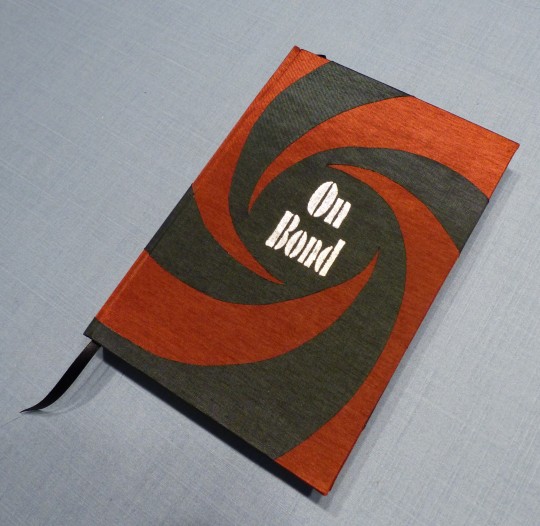
I used the gun barrel sequence as inspiration/template for the case design. Originally, I'd planned to make the two different linens fit together like a puzzle, buuut my cutting skills aren't that great and there would've been too many obvious gaps. 🙈 So I did two layers instead, which also doesn't take away much from the desired effect because the linen is quite thin.
The two copies I made are sisters, as I reversed the colours to save a bit of linen. I like the black circle a bit more, but am pleased with both copies.


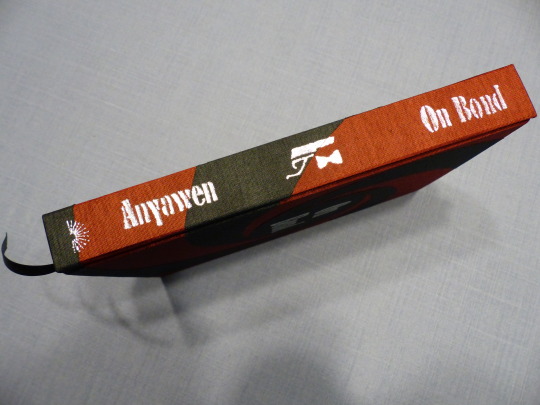
The typesetting took, uhhh, a long time. 😆 Just harvesting all those fics took several hours, and arranging them to my liking even more so. Anyawen had sent me a list with the fics she wanted to see in the book with different sections mentioned (series, stand-alone drabbles etc.). I used those sections for the book and arranged the fics in chronological order; there are perhaps a handful of exceptions where I had to switch around fics because it would have messed up the formatting (two dangling lines on the next page etc.).
I made an extensive Appendix for all the fic stats.

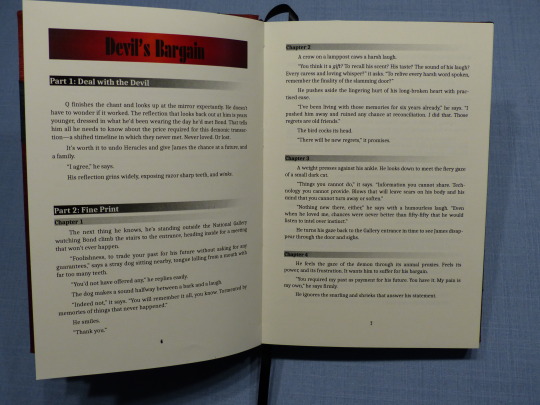
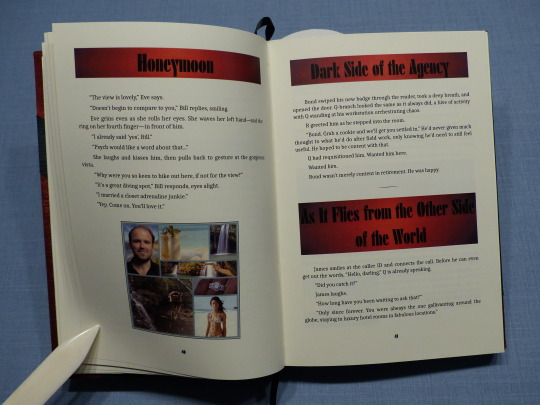
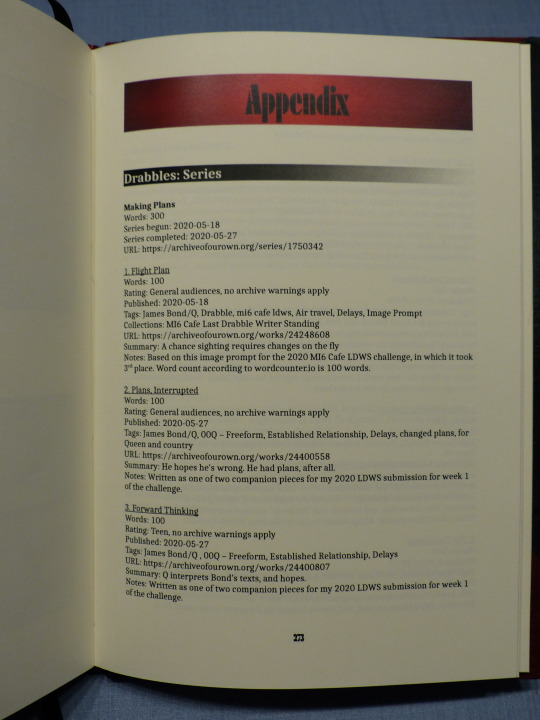
For the title page, I also used the gun barrel sequence as it's so iconic for the franchise. After I'd printed the book, I change the title page again because I didn't like how the first version came out in print. With this version, I'm very pleased though.

As Anyawen made several moodboards for her fics, I used that as inspiration for the section title pages. Making those was a lot of fun and I'm really pleased with how they came out.
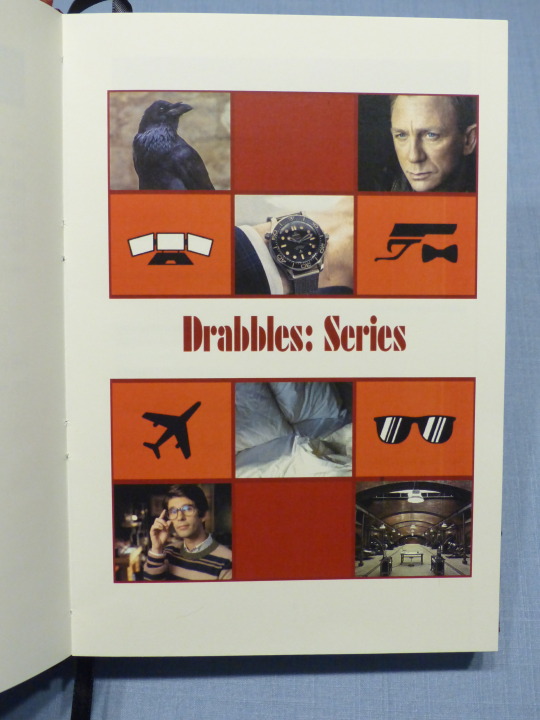


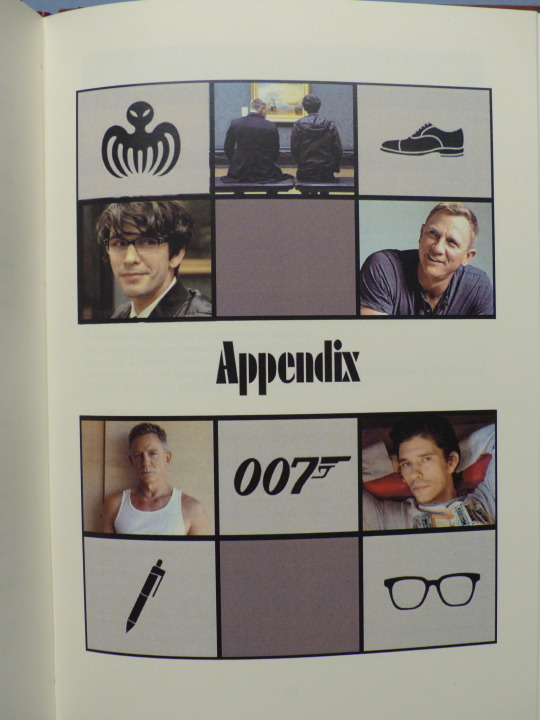
Thank you again, Anyawen, for participating in my FTH offer and giving me your trust with your fics! <3
Materials used:
Printed on Clairefontaine DCP 100g
Case and endpapers:
booklinen Colibri graphite
booklinen Colibri cranberry
Japanese paper Katazome 70g
Hot Foil (Memory Keepers)
#fanbinding#bookbinding#arts and crafts#my fanbinding#james bond#books#fth#fth 2024#fandom trumps hate#fth crafts bazaar
44 notes
·
View notes
Text

Karen Illman Miller, Beneath Pacific Tides/Tidepool Treasures, 2019, Silk Broadcloth, silk dupioni, cotton and wool batting, perle cotton, 28"x40"x1" (photo by Kayley Hoddick)
"My first love as a child and later as a professional marine biologist was always tide pools, still is. I could probably name every organism depicted here. The stones are typical of Puget Sound beaches, carried by glaciers from far away places. The stencils I used for this katazome quilt were among the first I cut when I began this art 24 years ago."
via
18 notes
·
View notes
Note
Never knew I needed Sherlock in a kimono this bad 😍 Fanart that recreates cannon is really cool, but I think fanart that adds something brand new to the world that we've never seen and wouldn't ever get to see otherwise is on a whole other level of awesome, like it makes me incredibly happy yet it only exists because of you! So thank youuu!!! 💕
Hi anon ^^
Thank you so much for enjoying my new Sherlock series and for taking the time to contact me, it's very kind of you. 💗
Never knew I needed Sherlock in a kimono this bad 😍
Not the art you wanted but the art you needed apparently. 😂
I had the idea after going to an exhibition devoted to kimonos at the Jacques Chirac Museum of Branly Quay in Paris. You had all sort of Japanese kimonos (obviously 🤓) but also "western kimonos" that showed how Japan has been a great influence in western fashion for centuries now (but also an influence in movie costumes. You even had Amidala's costume displayed ! ^^)
The idea to draw Sherlock in a kimono came after I saw these two pieces:

These garments were called a "banyan wrapper" (XVIIIth century). The one on the right dates back around 1720, pure silk, the fabric was dyed using a resist paste applied through a stencil (katazome). A lot were mass produced but these ones were orders.
Anyway, kimono fabric was imported from Japan to Europe by the Dutch in order to make beautiful dressing gowns like the ones above. Flower embroideries were popular but also colorful and shiny fabrics. When I went back home and had a look at the pics, I had a laugh and thought that Sherlock, being the absolute drama queen that he is, would absolutely own a kimono, even in the 1880s.
I tried several colors but bright red was the one that fitted him the best ! I love drawing Sherlock wearing blue (and I did it HERE on Twitter) but the red kimono on him was *chef's kisses* 🤌👨🍳
So thank youuu!!! 💕
No please! Thank YOU for enjoying my art so much! And thank you also to all the artists who create fan art. It's not because I'm an artist myself that I don't appreciate it. So many great works out there!
Have a great Sunday 💗
Edit: a big thank you to @semiprofessionalmom for their help with the post (see comments section)
58 notes
·
View notes
Text


gonna be looking like a koied carp
13 notes
·
View notes
Text

2022年制作
「満ち欠け暖簾-瑠璃紺-」
#katazome#dyeing#design#textiledesign#textile#art#artwork#noren#型染#かたぞめ#アート#アートワーク#テキスタイルデザイン#テキスタイル#デザイン#のれん#暖簾
2 notes
·
View notes
Text

Samiro Yunoki, Geometry, 1979 Stencil dye (katazome).
83 notes
·
View notes
Text

katazome-shi (stencil dyed paper, Japan)
24 notes
·
View notes
Text




[Image Description: four pictures of dye projects. The first is a stitched Shibori dye of a yellow dragon with a black background. the second is a Katazome paste-resist technique with yellow bird patterns with green background. The next two photos are of a tunic made with the green fabric. The first lays flat. The second is a close up of it on a mannequin with a leather vest and belt. End ID]
I've been considering doing more dying projects. SO! If you're interested in buying any fabric, scarves, dresses, ect, in this natural-fiber hand-printing dying styles, please give a reblog!
#art#fiber art#textiles#artists on tumblr#inkwell art#interest check#I'm trying to find out if I should buy all the supplies to get myself started more Professionally
16 notes
·
View notes























